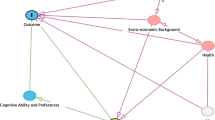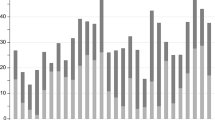Abstract
A risk of income fluctuations has two opposite impacts on the decision-making of those who contemplate suicide due to economic difficulties. First, an increase in this risk makes risk-averse people more likely to commit suicide by reducing their expected utility. Second, the increased risk makes them less likely to commit suicide by creating a value to waiting for their economic environment to improve. Standard models typically ignore the latter of the two impacts, however. In this paper, I allow the agents in the model to delay the action of committing suicide. From a series of simulations, I derive four conclusions. First, it is misleading to ignore the agents’ ability to wait when they are endowed with no debts. Second, the young who are endowed with no debts may choose to stay alive only to commit suicide in near future when their income is at high risk of fluctuations. Third, the young who are endowed with debts cannot utilise the ability to wait at all. Fourth, the divorced, ceteris paribus, are more likely to commit suicide than the married.




Similar content being viewed by others
References
Blanchard, O. J., & Fischer, S. (1989). Lectures on macroeconomics. Cambridge: MIT Press.
Brainerd, E. (2001). Economic reform and mortality in the former Soviet Union: A study of the psuicide epidemic in the 1990s. European Economic Review, 45(4–6), 1007–1019.
Browning, M., Chiappori, P. A., & Weiss, Y. (2014). Economics of the family. New York: Cambridge University Press.
Crouch, R. L. (1979). Human behavior: An economic approach. North Scituate: Duxbury Press.
Cutler, D. M., Glaeser, E. L., & Norberg, K. E. (2000). Explaining the rise in youth suicide. NBER Working Paper, 7713.
Dixit, A. K., & Pindyck, R. S. (1994). Investment under uncertainty. Princeton: Princeton University Press.
Hamermesh, D. S., & Soss, N. M. (1974). An economic theory of suicide. Journal of Political Economy, 82(1), 83–98.
Hansen, G. D. (1985). Indivisible labor and the business cycle. Journal of Monetary Economics, 16(3), 309–327.
Koo, J., & Cox, W. M. (2008). An economic interpretation of suicide cycles in Japan. Contemporary Economic Policy, 26(1), 162–174.
Kornai, J. (2000). What the change of system from socialism to capitalism does and does not mean. Journal of Economic Perspectives, 14(1), 27–42.
Kposowa, A. J. (2000). Marital status and suicide in the National Longitudinal Mortality Study. Journal of Epidemiology and Community Health, 54(4), 254–261.
Marcotte, D. E. (2003). The economics of suicide, revisited. Southern Economic Journal, 69(3), 628–643.
Smith, J. C., Mercy, J. M., & Conn, J. M. (1988). Marital status and the risk of suicide. American Journal of Public Health, 78(1), 78–80.
Suzuki, T. (2008). Economic modelling of suicide under income uncertainty: For better understanding of middle-aged suicide. Australian Economic Papers, 47(3), 296–310.
Acknowledgments
This research is supported by Grant-in-Aid for Scientific Research (C) from the Japan Society for the Promotion of Science (JSPS). The grant number is 23530345. I would like to thank an anonymous referee and participants of conferences, where this paper was presented at various stages, for constructive comments. Remaining errors are my responsibility.
Author information
Authors and Affiliations
Corresponding author
Rights and permissions
About this article
Cite this article
Suzuki, T. How will a risk of income fluctuations influence the suicidal decision making? Insights from a three-period model of suicide. Eurasian Econ Rev 5, 331–343 (2015). https://doi.org/10.1007/s40822-015-0022-9
Received:
Revised:
Accepted:
Published:
Issue Date:
DOI: https://doi.org/10.1007/s40822-015-0022-9




